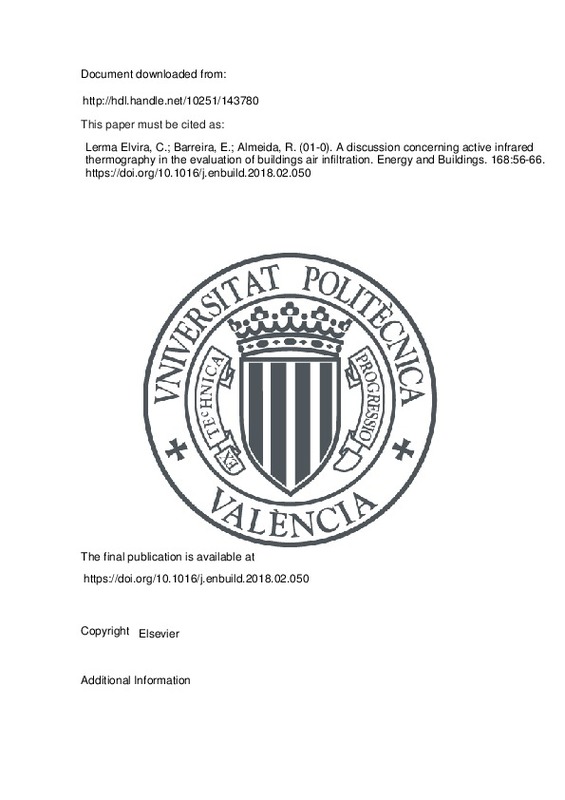JavaScript is disabled for your browser. Some features of this site may not work without it.
Buscar en RiuNet
Listar
Mi cuenta
Estadísticas
Ayuda RiuNet
Admin. UPV
A discussion concerning active infrared thermography in the evaluation of buildings air infiltration
Mostrar el registro sencillo del ítem
Ficheros en el ítem
| dc.contributor.author | Lerma Elvira, Carlos
|
es_ES |
| dc.contributor.author | Barreira, E.
|
es_ES |
| dc.contributor.author | Almeida, R.M.S.F.
|
es_ES |
| dc.date.accessioned | 2020-05-20T03:01:26Z | |
| dc.date.available | 2020-05-20T03:01:26Z | |
| dc.date.issued | 2018-06-01 | es_ES |
| dc.identifier.issn | 0378-7788 | es_ES |
| dc.identifier.uri | http://hdl.handle.net/10251/143780 | |
| dc.description.abstract | [EN] The EU is strongly committed to energy saving in buildings. Air leaks through the building envelope represent a significant percentage of buildings energy consumption. Locating and minimizing air leaks is thus necessary to optimize energy efficiency. This work presents the results of an experimental campaign that aimed to promote a discussion concerning the opportunities and constraints of using active IRT to detect air leakage points. The potential of active IRT was evaluated both in a qualitative approach, by comparing the thermograms with the ones obtained with passive IRT, and in a quantitative one, by testing methods of numerically interpret the thermograms. The results allowed concluding that active IRT increases the thermal contrast and the affected area, proving that active IRT combined with pressure differences is an effective methodology for detecting air infiltrations. In the quantitative approach different numerical methods can be used. Their selection depends on the aims of the study, as they can highlight different perspectives of the phenomenon. (C) 2018 Elsevier B.V. All rights reserved. | es_ES |
| dc.description.sponsorship | This work was financially supported by: Project POCI-01-0145-FEDER-007457 - CONSTRUCT - Institute of R&D In Structures and Construction funded by FEDER funds through COMPETE2020 - Programa Operacional Competitividade e Internacionalizacao (POCI) - and by national funds through FCT - Fundacao para a Ciencia e a Tecnologia. | es_ES |
| dc.language | Inglés | es_ES |
| dc.publisher | Elsevier | es_ES |
| dc.relation.ispartof | Energy and Buildings | es_ES |
| dc.rights | Reconocimiento - No comercial - Sin obra derivada (by-nc-nd) | es_ES |
| dc.subject | Active infrared thermography | es_ES |
| dc.subject | Qualitative analysis | es_ES |
| dc.subject | Quantitative analysis | es_ES |
| dc.subject | Leakage points | es_ES |
| dc.subject | Airtightness | es_ES |
| dc.subject.classification | CONSTRUCCIONES ARQUITECTONICAS | es_ES |
| dc.title | A discussion concerning active infrared thermography in the evaluation of buildings air infiltration | es_ES |
| dc.type | Artículo | es_ES |
| dc.identifier.doi | 10.1016/j.enbuild.2018.02.050 | es_ES |
| dc.relation.projectID | info:eu-repo/grantAgreement/FCT//POCI-01-0145-FEDER-007457/ | es_ES |
| dc.rights.accessRights | Abierto | es_ES |
| dc.contributor.affiliation | Universitat Politècnica de València. Departamento de Construcciones Arquitectónicas - Departament de Construccions Arquitectòniques | es_ES |
| dc.description.bibliographicCitation | Lerma Elvira, C.; Barreira, E.; Almeida, R. (2018). A discussion concerning active infrared thermography in the evaluation of buildings air infiltration. Energy and Buildings. 168:56-66. https://doi.org/10.1016/j.enbuild.2018.02.050 | es_ES |
| dc.description.accrualMethod | S | es_ES |
| dc.relation.publisherversion | https://doi.org/10.1016/j.enbuild.2018.02.050 | es_ES |
| dc.description.upvformatpinicio | 56 | es_ES |
| dc.description.upvformatpfin | 66 | es_ES |
| dc.type.version | info:eu-repo/semantics/publishedVersion | es_ES |
| dc.description.volume | 168 | es_ES |
| dc.relation.pasarela | S\355388 | es_ES |
| dc.contributor.funder | European Regional Development Fund | es_ES |
| dc.contributor.funder | Fundação para a Ciência e a Tecnologia, Portugal | es_ES |







![[Cerrado]](/themes/UPV/images/candado.png)

